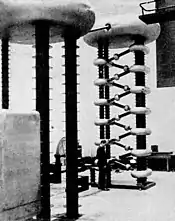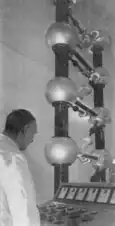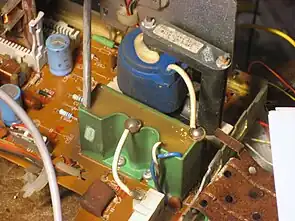
.jpg.webp)
The Cockcroft–Walton (CW) generator, or multiplier, is an electric circuit that generates a high DC voltage from a low-voltage AC or pulsing DC input. It was named after the British and Irish physicists John Douglas Cockcroft and Ernest Thomas Sinton Walton, who in 1932 used this circuit design to power their particle accelerator, performing the first artificial nuclear disintegration in history.[1] They used this voltage multiplier cascade for most of their research, which in 1951 won them the Nobel Prize in Physics for "Transmutation of atomic nuclei by artificially accelerated atomic particles".
The circuit was developed in 1919, by Heinrich Greinacher, a Swiss physicist. For this reason, this doubler cascade is sometimes also referred to as the Greinacher multiplier. Cockcroft–Walton circuits are still used in particle accelerators. They also are used in everyday electronic devices that require high voltages, such as X-ray machines and photocopiers.
Operation


The CW generator is a voltage multiplier that converts AC or pulsing DC electrical power from a low voltage level to a higher DC voltage level. It is made up of a voltage multiplier ladder network of capacitors and diodes to generate high voltages. Unlike transformers, this method eliminates the requirement for the heavy core and the bulk of insulation/potting required. Using only capacitors and diodes, these voltage multipliers can step up relatively low voltages to extremely high values, while at the same time being far lighter and cheaper than transformers. The biggest advantage of such circuits is that the voltage across each stage of the cascade is equal to only twice the peak input voltage in a half-wave rectifier. In a full-wave rectifier it is three times the input voltage. It has the advantage of requiring relatively low-cost components and being easy to insulate. One can also tap the output from any stage, like in a multi-tapped transformer.
To understand the circuit operation, see the diagram of the two-stage version at right. Assume all capacitors are initially uncharged, and the circuit is powered by an alternating voltage Vi such that Vi = Vp sin(t + π), i.e. with a peak value of Vp, which after power-on is 0 volts and starts with a negative half-cycle. After the input voltage is turned on
- When the input voltage Vi is decreasing and approaching its negative peak −Vp, current flows from the bottom terminal of the source, through diode D1 and then through capacitor C1, charging it. Vi eventually reaches the negative peak −Vp, at which point C1 is charged to a voltage of Vp. Vi then starts increasing ‒ its derivative dVi/dt reverses sign from negative to positive. When this happens, the current reverses its direction, since the load placed on the source is almost purely capacitive and thus current leads voltage by almost 90°.
- When Vi is increasing and approaching its positive peak +Vp, current flows from the top terminal of the source, through C1 (discharging it), through diode D2, and finally through capacitor C2 (charging it). Eventually, Vi reaches +Vp, and when we add to it the voltage of C1 (which is now slightly below +Vp), we get the resulting voltage of almost 2Vp ‒ this is the voltage to which C2 is charged. In this phase, diode D1 is reverse-biased, so no current flows through it.
- When Vi starts decreasing again (dVi/dt is negative), current flows from the bottom terminal of the source, through C2 (discharging it), through diode D3, through C3 (charging it to a voltage of almost 2Vp), and finally through C1 (recharging it to Vp, after it was partially discharged in the previous phase). Since some voltage is dropped also on C1 and not just on C3, C3 will not be charged to 2Vp immediately, but only in later iterations. The same applies to C1 and Vp respectively. Also, in this phase, C2 discharges to a voltage below 2Vp, similarly to C1 in the previous phase. It will be recharged in the next phase.
- When Vi begins to increase again, current flows from the top terminal of the source, through C1 and C3 (discharging them), through diode D4, through C4 (charging it to a voltage of almost 2Vp), and finally through C2 (recharging it). During this phase, C1 and C3 discharge below Vp and 2Vp respectively, and will be recharged in the following phase.
At any given moment, either the odd-numbered diodes are conducting, or the even-numbered ones, never both. With each change in the derivative of input voltage (i.e. dVi/dt), current flows up to the next level in the "stack" of capacitors through the diodes. Eventually, after a sufficient number of cycles of the AC input, all capacitors will be charged. (More precisely, we should say their actual voltages will converge sufficiently close to the ideal ones ‒ there will always be some ripple from the AC input). All the capacitors are charged to a voltage of 2Vp, except for C1, which is charged to Vp. The key to the voltage multiplication is that while the capacitors are charged in parallel, they are connected to the load in series. Since C2 and C4 are in series between the output and ground, the total output voltage (under no-load conditions) is Vo = 4Vp.
This circuit can be extended to any number of stages. The no-load output voltage is twice the peak input voltage multiplied by the number of stages N or equivalently the peak-to-peak input voltage swing (Vpp) times the number of stages
The number of stages is equal to the number of capacitors in series between the output and ground.
One way to look at the circuit is that it functions as a charge "pump", pumping electric charge in one direction, up the stack of capacitors. The CW circuit, along with other similar capacitor circuits, is often called a charge pump. For substantial loads, the charge on the capacitors is partially depleted, and the output voltage drops according to the output current divided by the capacitance.
Characteristics
In practice, the CW has a number of drawbacks. As the number of stages is increased, the voltages of the higher stages begin to "sag", primarily due to the electrical impedance of the capacitors in the lower stages. And, when supplying an output current, the voltage ripple rapidly increases as the number of stages is increased (this can be corrected with an output filter, but it requires a stack of capacitors in order to withstand the high voltages involved). For these reasons, CW multipliers with large number of stages are used only where relatively low output current is required. The sag can be reduced by increasing the capacitance in the lower stages, and the ripple can be reduced by increasing the frequency of the input and by using a square waveform. By driving the CW from a high-frequency source, such as an inverter, or a combination of an inverter and HV transformer, the overall physical size and weight of the CW power supply can be substantially reduced.
CW multipliers are typically used to develop higher voltages for relatively low-current applications, such as bias voltages ranging from tens or hundreds of volts to millions of volts for high-energy physics experiments or lightning safety testing. CW multipliers are also found, with a higher number of stages, in laser systems, high-voltage power supplies, X-ray systems, CCFL LCD backlighting, traveling-wave tube amplifiers, ion pumps, electrostatic systems, air ionisers, particle accelerators, copy machines, scientific instrumentation, oscilloscopes, television sets and cathode-ray tubes, electroshock weapons, bug zappers and many other applications that use high-voltage DC.
The Dynamitron is similar to the Cockcroft–Walton generator. However instead of being powered at one end as in the Cockcroft-Walton, the capacitive ladder is charged in parallel electrostatically by a high frequency oscillating voltage applied between two long half-cylindrical electrodes on either side of the ladder column, which induce voltage in semicircular corona rings attached to each end of the diode rectifier tubes.[2]
Image gallery




See also
Notes
- ↑ Kleppner, Daniel; Kolenkow, Robert J. (1973). An Introduction to Mechanics (2nd ed.). Boston: McGraw-Hill. p. 498. ISBN 0-07-035048-5.
- ↑ Nunan, Craig S. (26 May 1989). Present and Future Applications of Industrial Accelerators (PDF). Proceedings of the 9th Fermilab Industrial Affiliates Roundtable on Applications of Accelerators. Fermilab, Batavia, Illinois: Stanford Linear Accelerator Center. p. 64. Retrieved 30 July 2020.
Further reading
- J. D. Cockcroft and E. T. S. Walton, Experiments with High Velocity Positive Ions.(I) Further Developments in the Method of Obtaining High Velocity Positive Ions, Proceedings of the Royal Society A, vol. 136, pp. 619–630, 1932.
- J. D. Cockcroft and E. T. S. Walton, Experiments with High Velocity Positive Ions. II. The Disintegration of Elements by High Velocity Protons, Proceedings of the Royal Society A, vol. 137, pp. 229–242, 1932.